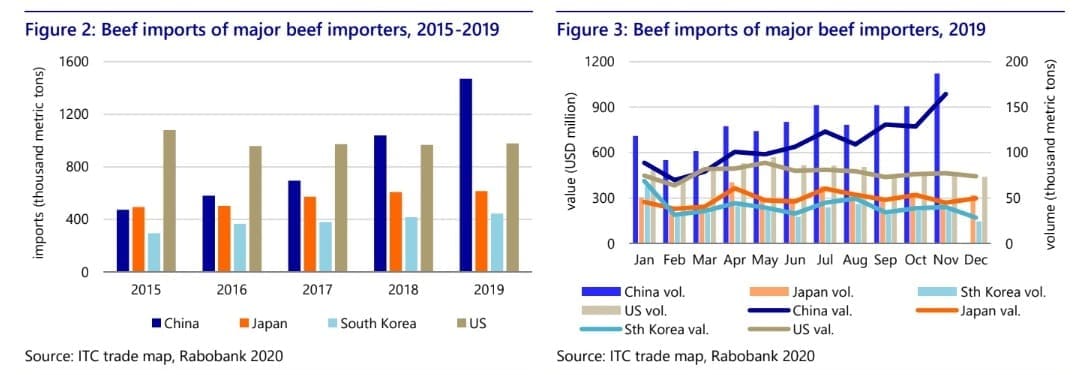Recent widespread rainfall has buoyed Australian beef producer spirits and lifted cattle prices, but the sector faces reduced export demand from China as a result of coronavirus, according to Rabobank’s latest global Beef Quarterly report.
In its Q1 report, Rabo expects China to again dominate beef imports in 2020, albeit at a far slower rate than the heady 60 percent increase in imported volume recorded in 2019.
Rabobank senior animal proteins analyst Angus Gidley-Baird said while it was hard to predict how long coronavirus would disrupt the Chinese market, lower sales volumes and limited cash flows would delay a return to normal beef imports in the short term.
“We do, however, expect China’s beef imports to continue to grow in 2020, with a strong rebound in the second half of the year,” he said.
Coronavirus effects on Chinese imports
With a high inventory of frozen beef unconsumed over the Lunar New Year, and a significant percentage of the Chinese public avoiding eating out entirely, China’s beef demand will be down, Mr Gidley-Baird said.
“Food service and tourism will remain disrupted until the virus is contained, with decreased restaurant sales contributing to weaker beef demand in the first half of the year than in previous years,” he said.
“Importers also face the additional challenge of limited cash flow due to unsold stock at ports, and financial losses incurred in the late-2019 price plunge.”
A slowing economy and side-effects of coronavirus could curb the extraordinary increase in beef import volumes China experienced in 2019, and potentially lower global prices, particularly in the first half of 2020, but Mr Gidley-Baird expected demand to improve over the second half of the year.
Coronavirus dents demand
Rabo expects Chinese beef consumption to have been hit hard by the coronavirus outbreak and associated government measures, including lockdowns of city centres, disruption to transportation, and closure of many public areas including restaurants.
China’s consumption of beef, together with lamb and seafood, is generally associated with eating out, and especially full-service restaurants and hotpot. The closure of many foodservice outlets in January and February suggests that sales of beef would have declined substantially.
China’s fresh beef retail prices increased to RMB 83/kg in January before the Lunar New Year, up 20pc year-on-year. Prices moved up further to a record high of RMB 85/kg in the first week of February.
Transportation disruptions and the closure of some retail stores have caused the short supply of fresh produce, including animal protein and vegetables in many regions, forcing prices up Beef production in 2019 increased to 6.67m metric tons, up 3.6% YOY. This pace is much stronger than the previous years – the CAGR between 2013 and 2018 was below 1%. The shift from pork consumption to other protein consumption, including beef, as a result ofAfrican swine fever is a key reason for the strong growth of local beef production. However, we expect beef production to slow in 2020, as a slower economy and income growth will restrict consumers’ purchasing power.
China’s beef imports increased to 1.69m metric tons in 2019, up 60% YOY, driven by the shutdown of grey channels and strong local demand. With the signing of the US-China phase-one agreement in January 2020, China is expected to import more US beef. However, the sudden hit by coronavirus on China’s economy will cause short-term uncertainty as higher-priced US beef is usually positioned for the high-end market, which will shrink under a slowing economy.
Australian outlook
Mr Gidley-Baird said recent rainfall across large areas of Australia had ensured an increase in cattle prices as competition for limited stock heated up.
“Producers are flocking to the saleyards, with the recent rain providing an opportunity to restock and rebuild breeding numbers after such a prolonged dry period,” he said.
The Eastern Young Cattle Indicator lifted 21pc from 513c/kg cwt in November 2019 to 623c/kg on 14 February 2020 and now sits above 700c/kg, reflective of this turnaround.
Despite the drought, Australian beef exports for 2019 were strong thanks largely to China, where 2019 exports eclipsed 2018 by 84pc.
By year end, China’s market share of Australian beef exports increased from 14pc to 24pc. Australian exports to the US also increased 9pc, while exports to Japan were down 9pc, year over year.
With almost a quarter of Australia’s beef exports exposed to the Chinese market, a reduced demand was now expected due to coronavirus, and Mr Gidley-Baird said the potential lower global prices could prove challenging for processors, given the strong domestic livestock prices being paid.
Source: Rabo




HAVE YOUR SAY